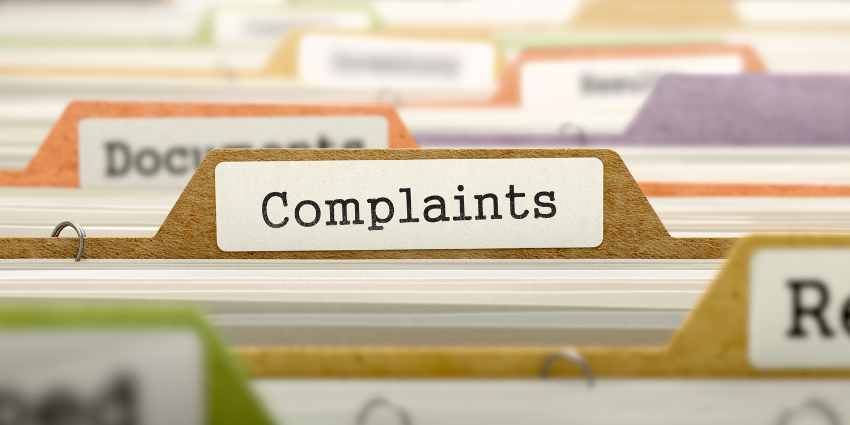How To Write a Complaints Procedure
Regardless of the industry or sector you work in, having a structured and effective Complaints Procedure is an imperative part of good customer service. Most complaint handling procedures follow a similar pattern which include acknowledgments, timeframes, investigation processes and final responses.
Some business types are regulated or governed by a professional body and will have specific rules and requirements to follow when developing their complaint procedures. The most well known of these is the Financial Ombudsman Service (FOS) who help to settle complaints between consumers and businesses offering financial services.
You do not have to be in the financial services sector to benefit from the complaint handling process the FOS suggest for those they regulate. Utilising similar complaint acknowledgment protocols, response timeframes and investigation tools can ensure that any business is handling customer complaints in an effective manner.

The Institute of Customer Service (UKCSI) state that in 2021 14.9% of customers exoerienced an issue with an organisation.
Headings in a Complaint Procedure Template
If you are using a Complaint Procedure Template as your foundation, you will notice that most of the headings and sections are quite similar from template to template. The Know Your Compliance Complaint Handling Policy & Procedure contains the below sections, which are provided here as guidance and are not exhaustive.
- Policy Statement
- Purpose & Scope
- Objectives
- Procedures & Guidelines
- Raising a Complaint
- Data Protection Related Complaints
- Informal Complaint Resolution
- Timeframe for Informal Resolution
- Responding to a Complaint
- Investigating the Complaint
- Decision Letter (Final Response)
- Complaint Recording
- Patterns and Analysis
- Responsibilities
- The Complaint Officer
Raising a Complaint
One of the most important sections in the complaint handling policy and procedure is documenting how a customer can raise a complaint and ensuring that the controls and measures for this are accessible. You should provide numerous ways for a customer to raise an issue, which can include via your website, in writing, by email, over the phone or face to face. With social media being such a prominent part of communication and marketing for businesses nowadays, it is also common for some organisations to accept complaints via social media platforms.
It is important to document in the complaint procedure template what types of issues should be dealt with as an official complaint. In todays’ customer focussed climate, many organisations choose to follow their complaint protocols for any issue raised by a customer. This can help to ensure that minor issues do not turn into larger complaints.
Complaint Resolution Examples
You can have both informal and formal complaint resolution as part of your procedures. Some issues are minor and can be resolved with a simple phone call or written communication.
Whilst these should be documented on any complaint log, they do not necessarily need to follow the timescales and final response processes. However, all issues and complaints should be acknowledged in writing to ensure you have a record of any communication and resolutions.

Formal complaints should have a dedicated process within your complaint procedures document and should always follow your documented process and timeframes. This can include acknowledging a complaint in writing within 3 working days of receipt of the issue. Using standard response templates to ensure all complaint communication is structured and consistent. Carrying out an investigation of the issue and putting any actions into place (where required). Responding to the complainant with a final written response and notifying them of any bodies they can contact should they be unhappy about the outcome.
Investigating a Complaint
Not all types of complaint require investigation. Some issues are obvious and can be resolved without the need to review or change any factors. However, there are instances when an investigation is an essential part of complaint resolution and finding out why something went wrong in the first place.
The bullet points on the right are some suggestions on when to initiate an investigation into a complaint. They are by no means exhaustive, but can serve as guidance on which to build.
It is important that when an investigation is required, all evidence, interviews, actions taken and outcomes are fuly documented and saved. This can help with future reviews, complaint pattern analysis and for providing proof should it be required.
- The complainant has requested an investigation
- The complaint involves a personal data issue
- The informal complaint resolution stage failed or was inappropriate
- There is a conflict of interest between the complainant and an employee
- The issues are complex and require an investigation
- The complaint represents a high or serious risk to the company
- The facts are unclear, or the complaint will require additional time to resolve
- The complainant is identified as being vulnerable
- There has been any media contact or attention
- Child protection issues are involved
- The issues do or may affect more customers
- A professional body or supervisory authority requires it
Complaint Procedure Template
There are numerous other sections and content that must go into a complaint procedure. It is also best practice to use complaint response templates that are structured but also customisable so that complaint processes and responses follow a consistent approach. Using a complaint log will allow for easy pattern analysis and provides essential management information.
We provide an extensive Complaints Procedure Template set which contains a customisable, but ready to use complaint policy and procedure template. We have also included sample responses for acknowledgments, informal and formal responses, timeframe delays, request for more information and final responses (both upheld and rejected). The set also comes with a blank complaint log and complaint handling checklist so you can audit and review your existing complaint processes for compliance.
For just £85 (exc vat) you can save yourself time and money by using our professional, hightly recommended complaint handling templates. With over 5500 organisations currently using our templates, we are a market leader in policy development.
